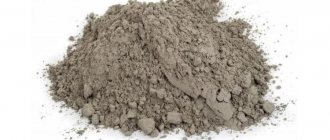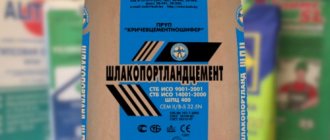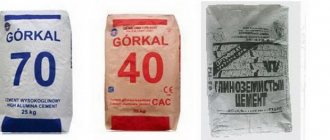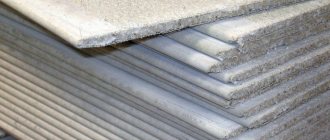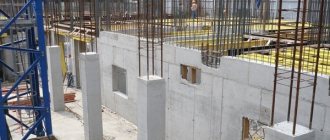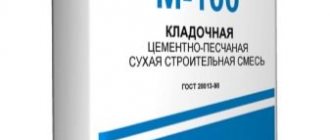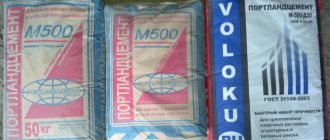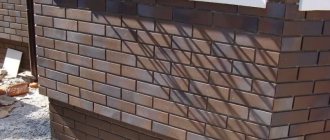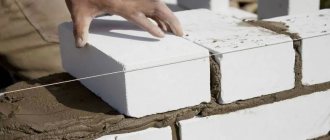GOST 1078-85
INTERSTATE STANDARD
PORTLAND CEMENT AND SLAG PORTLAND CEMENT
TECHNICAL CONDITIONS
IPC PUBLISHING HOUSE OF STANDARDS Moscow
INTERSTATE STANDARD
| PORTLAND CEMENT AND SLAG PORTLAND CEMENT Specifications Portland cement and portland blastfurnace slag cement. Specifications | GOST 10178-85 |
Date of introduction 01/01/87
This standard applies to cements for general construction purposes based on Portland cement clinker.
The standard does not apply to cements that have special requirements and are manufactured according to the relevant standards and specifications.
Classification, terms and definitions - according to GOST 30515.
(Changed edition, Amendment No. 1, 2).
Stamps
Based on the requirements of regulatory documentation for a cement sample subjected to compression and bending tests, we can distinguish the main grades of Portland cement:
M700 is a particularly durable composition. The scope of application is limited to the production of concrete with increased strength characteristics for the construction of stressed structures. The price of such cement is high, which makes it unprofitable for ordinary construction activities;
Any type of Portland cement grade 400 is used to create ordinary and standard structures that are not subject to increased loads
- M600 – composition of increased strength. Scope of application – production of critical reinforced concrete products and structures;
- M500 is a cement that has fairly good strength properties, which allows it to be used in the reconstruction of buildings and structures after accidents, the construction of military-technical facilities, and the laying of road surfaces;
- M400 is the most affordable and widely used brand. This is explained by the fact that the built-in indicators of frost resistance and moisture resistance allow it to be used in the construction of objects for any purpose.
Manufacturers produce Portland cement of the M200 and M300 brands, but in rather limited quantities. This limitation is natural, since the demand for these brands is small.
| Brand of Portland cement (GOST 10178-85, GOST22236-85) | Strength class (GOST 31108-2003) |
| 300 | 22.5N |
| 400 | 32.5N |
| 400B | 32.5B |
| 500 | 42.5N |
| 500B | 42.5B |
| 550 | 52.5N |
| 600 | 52.5B |
Class and brand are expressed in different units of measurement - in MPa and kgf/cm2, respectively. Differences in the numerical values of class and grade when expressed in the same units of measurement are due only to different cement testing conditions.
Application. Portland cement is the main material of the modern construction industry, used for mortars, concrete and reinforced concrete products and structures, for special types of cement, as well as in the manufacture of a number of other building materials.
– regulation of the chemical and mineral composition and structure of cement clinker;
– change in the material (component) composition of cement (introduction of additives);
– regulation of grinding fineness and grain composition of cement.
The grade is defined as the strength of a sample when tested in bending and compression. To make a sample, Portland cement and sand are used, taken in a ratio of 1: 3. A sample measuring 4x4x16 cm is made from this solution, which hardens within 28 days, hardening occurs in conditions of high humidity. To speed up hardening, it is allowed to resort to the technique of steaming the sample.
The most common brands of Portland cement today are M 400, 500, 600:
M 400 is the most popular brand of cement. The technical characteristics contained in it (strength, frost resistance) are suitable for the construction of most objects.
M 500 is a cement that has a slightly larger margin of safety, which allows it to be used in reconstruction or restoration of objects after an accident, used for road repair work, construction of military-technical facilities, and asbestos-cement structures.
There are also “intermediate” grades of cement, for example M 550 (in terms of their technical characteristics they are close to M500, but are slightly more durable).
TECHNICAL REQUIREMENTS
1.1. Cement must be manufactured in accordance with the requirements of this standard according to technological regulations approved in the manner established by the manufacturer's ministry.
1.2. Based on their material composition, cement is divided into the following types:
Portland cement (without mineral additives);
Portland cement with additives (with active mineral additives no more than 20%);
Portland slag cement (with additions of granulated slag more than 20%).
(Changed edition, Amendment No. 2).
1.3. Based on compressive strength at 28 days of age, cement is divided into grades:
Portland cement - 400, 500, 550 and 600;
Portland slag cement - 300, 400 and 500;
quick-hardening Portland cement - 400 and 500;
quick-hardening Portland slag cement - 400.
Note. It is allowed, with the permission of the USSR Ministry of Construction Materials, to produce Portland cement with mineral additives of grade 300.
1.4. The symbol for cement should consist of:
Names of cement type - Portland cement, Portland slag cement. It is allowed to use an abbreviated designation of the name - PTs and ShPTs, respectively;
grades of cement - according to clause 1.3;
designations of the maximum content of additives in Portland cement according to clause 1.6: D0, D5, D20;
designations of fast-hardening cement - B;
designations for plasticization and hydrophobization of cement - PL, GF;
designation of cement obtained from clinker of standardized composition - N;
symbols of this standard.
An example of a symbol for Portland cement grade 400, with additives up to 20%, quick-hardening, plasticized:
Portland cement 400-D20-B - PL GOST 10178-85.
The following designation is allowed (except for cases of supply of cement for export):
PC 400-D20-B - PL GOST 10178-85.
1.5. In the production of cements the following is used:
clinker, the chemical composition corresponding to the technological regulations. Mass fraction
Magnesium oxide (MgO) in clinker should not be more than 5%.
For individual enterprises, according to the list established by the USSR Ministry of Construction Materials, due to the peculiarity of the chemical composition of the raw materials used, the MgO content in clinker is allowed to exceed 5%, but not more than 6%, provided that uniform changes in the volume of cement are ensured when tested in an autoclave;
gypsum stone according to GOST 4013-82. The use of phosphogypsum, borogypsum, fluorogypsum is allowed in accordance with the relevant regulatory and technical documentation;
granulated blast furnace or electrothermophosphorus slags in accordance with GOST 3476-74 and other active mineral additives in accordance with the relevant regulatory and technical documentation;
additives that regulate the basic properties of cement, and technological additives in accordance with the relevant regulatory and technical documentation.
1.6. The mass fraction of active mineral additives in cements must correspond to the values indicated in the table. 1.
Table 1
| Active mineral additives,% by weight | ||||
| Designation of cement type | Total | Including | ||
| blast furnace granulated and electrothermophosphorus slags | sedimentary origin, except gliège | other actives, including gliezh | ||
| PC-D0 | Not allowed | |||
| PC-D5 | Up to 5 | Up to 5 | Up to 5 | Up to 5 |
| PC-D20, PC-D20-B | St.5 to 20 | Up to 20 | To 10 | Up to 20 |
| ShPTs, ShPTs-B | St. 20 to 80 | St.20 to 80 | To 10 | To 10 |
It is allowed to replace part of the mineral additives in all types of cement with additives that accelerate hardening or increase the strength of cement and do not impair its construction and technical properties (rents, sulfoaluminate and sulfoferritic products, calcined alunites and kaolins). The total mass fraction of these additives should not be more than 5% of the cement mass.
1.7. The tensile strength of cement in bending and compression must be no less than the values indicated in table. 2.
table 2
| Designation of cement type | Guaranteed | Tensile strength, MPa (kgf/sq.cm) | |||
| brand | when bending at age, days | with compression at age, days | |||
| 3 | 28 | 3 | 28 | ||
| PC-D0, PC-D5, | 300 | — | 4,4 (45) | — | 29,4 (300) |
| PC-D20, ShPTs | 400 | — | 5,4 (55) | — | 39,2 (400) |
| 500 | — | 5,9 (60) | — | 49,0 (500) | |
| 550 | — | 6,1 (62) | — | 53,9 (550) | |
| 600 | — | 6,4 (65) | — | 58,8 (600) | |
| PC-D20-B | 400 | 3,9 (40) | 5,4 (55) | 24,5 (250) | 39,2 (400) |
| 500 | 4,4 (45) | 5,9 (60) | 27,5 (280) | 49,0 (500) | |
| ShPTs-B | 400 | 3,4 (35) | 5,4 (55) | 21,5 (220) | 39,2 (400) |
The manufacturer must determine the steaming activity of each batch of cement.
1.2-1.7. (Changed edition, Amendment No. 1).
1.8. The cement must show a uniform change in volume when testing samples by boiling in water, and when the MgO content in the clinker is more than 5% - in an autoclave.
1.9. The beginning of cement setting should occur no earlier than 45 minutes, and the end should occur no later than 10 hours from the start of mixing.
1.10. The fineness of cement grinding must be such that when sifting a cement sample through a sieve with mesh N 008 in accordance with GOST 6613-86, at least 85% of the mass of the sifted sample passes.
1.11. The mass fraction of sulfuric acid anhydride (SO(3)) in cement must comply with the requirements of Table. 3.
Table 3
| SO(3), % by mass | ||
| Designation of cement type | No less | No more |
| PC 400-D0, PC 500-D0, PC Z00-D5, PC 400-D5, PC 500-D5, PC 300-D20, PC 400-D20, PC 500-D20. | 1,0 | 3,5 |
| PC 550-D0, PC 600-D0, PC 550-D5, PC 600-D5, PC 550-D20, PC 600-D20, PC 400-D20-B, PC 500-D20-B | 1,5 | 4,0 |
| ShPTs 300, ShPTs 400, ShPTs 500, ShPTs 400-B | 1,0 | 4,0 |
1.12. It is allowed to introduce special plasticizing or water-repellent surfactant additives into cement during its grinding in an amount of no more than 0.3% of the cement mass in terms of the dry substance of the additive.
Plasticized or hydrophobic cement should be supplied by agreement between the manufacturer and the consumer.
Plasticized or hydrophobic cement should not be supplied to consumers who use superplasticizers in the preparation of concrete mixtures.
The mobility of a cement-sand mortar with a composition of 1:3 from plasticized cements of all types must be such that, with a water-cement ratio of 0.4, the spread of a standard cone is at least 135 mm.
Hydrophobic cement should not absorb water within 5 minutes from the moment a drop of water is applied to the surface of the cement.
1.13. When producing cement to intensify the grinding process, it is allowed to introduce technological additives that do not impair the quality of cement in an amount of no more than 1%, including organic additives of no more than 0.15% of the cement mass.
The effectiveness of the use of technological additives, as well as the absence of their negative impact on the properties of concrete, must be confirmed by the results of tests of cement and concrete.
1.14. For concrete road and airfield pavements, reinforced concrete pressure and free-pressure pipes, reinforced concrete sleepers, bridge structures, racks of high-voltage power transmission lines, contact networks of railway transport and lighting, cement must be supplied based on clinker of a standardized composition containing tricalcium aluminate (C(3) A) in an amount not exceeding 8% by weight.
For these products, in agreement with the consumer, it is necessary to supply one of the following types of cement:
PC 400-D0-N, PC 500-D0-N - for all products;
PC 500-D5-N - for pipes, sleepers, supports, bridge structures, regardless of the type of additive (for pressure pipes, cement of group I or II for steaming efficiency must be supplied according to Appendix A);
PTs 400-D20-N, PTs 500-D20-N - for concrete road and airfield pavements when using granulated slag as an additive of no more than 15%.
The beginning of setting of Portland cement for concrete road and airfield pavements should occur no earlier than 2 hours, Portland cement for pipes - no earlier than 2 hours 15 minutes from the start of cement mixing. By agreement between the manufacturer and the consumer, other setting times are allowed.
The specific surface area of Portland cement with the addition of slag for concrete road and airfield pavements must be at least 280 sq.m/kg.
1.12, 1.14. (Changed edition, Amendment No. 1, Amendment No. 2).
1.15. Mass fraction of alkali oxides (Na(2)O and K(2)O) in terms of Na(2)O (Na(2)O + 0.658 K(2)O) in cements intended for the manufacture of massive concrete and reinforced concrete structures using reactive filler, installed in agreement with the consumer.
1.16. The mass fraction of alkali oxides in cements produced using belite (nepheline) slurry, calculated as Na(2)O, should not be more than 1.20%.
(Changed edition, Amendment No. 1).
1.17. (Deleted, Amendment No. 2).
1.18. The manufacturer must test cement for signs of false set evenly throughout shipment, but not less than 20% of shipments.
(Introduced additionally, Amendment No. 1).
Clinker minerals and concrete degradation
All types of cements differ significantly in mineralogical and chemical composition, since the sources of raw materials and the ratio of raw materials are different.
Four types of minerals
Scientists from different countries have made attempts to control the properties of cements for accurate classification by type of purpose and to eliminate the procedure of constant physical tests. But an attempt to establish the maximum ratios and quantities taken as a basis for four clinker materials was unsuccessful. The reason for the failure is that the mineralogical composition of the raw materials cannot be sufficiently accurate and does not take into account the required properties of cement, which means control physical tests of cement are necessary.
Main clinker minerals
- C2S - dicalcium and C3S - tricalcium silicates;
- C4AF tetracalcium aluminoferite;
- C3A - tricalcium aluminate.
Mechanism of concrete destruction
Interacting with water containing sulfates, C3A aluminate. calcium hydrosulfoaluminate is formed with further crystallization in the concrete structure. This leads to expansion of the volume with subsequent destruction of concrete.
Such crystallization is most often observed with a large number of cycles of concrete flooding followed by drying. First of all, this applies to hydraulic structures - bridge supports, buried piles, submerged foundations.
Even efflorescence crystals on a brick wall can lead to its destruction. Reinforced concrete reinforcement is also subject to similar processes; anti-corrosion additives are used to protect against them.
TEST METHODS
3.1. Determination of the physical and mechanical properties of cements is carried out according to GOST 310.1-76 - GOST 310.3-76, GOST 310.4-81.
3.2. Chemical analysis of clinker and cement is carried out according to GOST 5382-73.
In this case, the mass fraction of magnesium oxide (MgO) in clinker is established according to production acceptance control data.
3.3. The type and amount of additives in cement are determined according to the methodology of the parent organization for state testing of cement in a sample taken at the manufacturing plant.
3.4. (Deleted, Amendment No. 2).
3.5. The presence of signs of false setting of cement is checked according to the methods of the parent organization for state testing.
(Changed edition, Amendment No. 1).
3.6. (Deleted, Amendment No. 1).
Differences from simple cement
Portland cement is a type of cement that is considered the most suitable and justified for pouring concrete. Concrete is used in monolithic/reinforced concrete construction, in the process of constructing various objects that require increased requirements for strength and ability to withstand loads.
Clinker granules and other additives in Portland cement make it more durable, resistant to frost, external negative factors and aggressive environments. It should be noted that this description is suitable for almost all types of Portland cement, which makes it in demand in the construction of gas and oil industry facilities.
Also, this type of binder is suitable for pouring foundations on unstable complex soils - usually they choose, which eliminates shrinkage and the spread of cracks along the monolith.
When trying to determine how cement differs from Portland cement, you need to remember that they are related as a general class of binder and one of its types. Portland cement is a stronger type of cement. And obvious differences can be determined by considering specific brands and types of Portland cement by composition. The same aspects as setting technology, mixing features, installation method, application, etc. similar.
Where to buy cement m500 in bags at retail?
In the process of purchasing cement, organizations may encounter the following errors:
1) Intermediaries. These subjects of market relations act as just another layer between the buyer and the cement manufacturer, increasing the final cost of cement.
2) Counterfeit. Finding yourself purchasing a counterfeit is a dangerous but popular practice in the domestic market.
3) Deadlines. Random speculators work according to the scheme: “I found a buyer - I’m looking for a product,” so delivery on time is impossible for them.
4) One-time transactions. Many resellers are not capable of long-term business relationships.
To avoid these problems and buy cement without risking your business, you must immediately contact a reliable supplier.
Cement production technology
Cement production - video
https://youtube.com/watch?v=GVWuaBGyixw
Cement production is an energy-intensive and expensive process consisting of two stages:
- Obtaining clinker. To begin with, raw materials, in particular limestone, are extracted by mining limestone deposits. Then the material is crushed into pieces with a diameter of 10 cm, dried and mixed with other constituent elements. After this, the raw material mixture is fired. The result is the so-called clinker.
- Turning clinker into powder. At this stage, clinker and gypsum stone are crushed, mineral additives are dried, and then all components are ground together. However, the quality and physical and technical characteristics of raw materials (humidity, density, etc.) vary, so the methods for producing cement may vary.
Cement production methods
Currently, the cement industry produces cement in three main ways:
- Wet. It is used when cement is created from clay (silicate component), chalk (carbonate product) and additives containing iron (converter sludge, pyrite cinders, ferrous product). In this case, the moisture content of chalk should be no more than 29%, and the moisture content of clay should be no more than 20%. The grinding of the raw material mixture takes place in an aqueous environment, and the result is a mixture in the form of sludge dissolved in water with a moisture content of 30 to 50%. Then the sludge is sent for firing to a special furnace with a diameter of 7 m and a length of 200 m. During the firing process, carbon dioxide is released from the raw material and clinker balls are formed. They are ground into powder, thus obtaining the required grade of cement.
- Dry. The peculiarity of this method is that all raw materials are dried before (or during) grinding. Therefore, the raw material mixture is immediately obtained in the form of crushed dry powder.
- Combined. In this case, cement can be produced using two different technologies: the raw material mixture is prepared in the form of sludge mixed with water, and then dehydrated to a moisture content of 16-18% using special filters and sent to a kiln, after which it is crushed and turned into cement.
- the raw material mixture is dried and crushed, and the resulting mixture is granulated by adding 10-14% water and fed for firing. The granules are then removed from the oven and ground.
In the past, cement was mostly produced using the wet method, but nowadays dry technology is preferred.
How to choose a cement production method?
1. Heat consumption increases significantly with the wet method of cement production. But the presence of water in mills makes it easier to grind raw materials. Therefore, if the moisture content of the feedstock is more than 10%, then it is most advisable to create cement using wet technology.
2. If the raw material mixture consists of two soft materials, it is also preferable to produce cement using the wet method, since the raw materials are easily crushed by ordinary stirring in water.
3. The dry method is used if the moisture content of the raw materials is no more than 10%.
4. If the raw material is sufficiently plastic, then you can give preference to the combined method of cement production.
Composition and properties
As already mentioned, Portland cement consists of clinker. In nature, ready-made granules are quite rare, so clinker crumbs are produced artificially by mixing and firing carbon and clay mixtures.
The finished clinker is mixed with gypsum, the content of which does not exceed 5%. It is introduced in order to ensure the mobility of the solution for 45 minutes, which is necessary when molding products or performing certain types of work.
The composition and percentage of mixture components is regulated by GOST 10178 85 “Portland cement and Portland slag cement”. It is compliance with state requirements during production that guarantees high technical and operational characteristics of the product.
To give Portland cement certain technical characteristics, mineral additives are added to the composition, the content of which does not exceed 20-25%.
The most popular are the following:
- Aluminate increases the setting time of cement, but has low strength indicators (possible content in Portland cement is no more than 15%).
- Aluminum ferrite has the same properties as the previous additive, however its content in the finished product is reduced to 10-18%.
- Belite has an astringent effect and helps to increase the hardening time, however, excessive content can negatively affect the strength characteristics of the composition (permissible content is no more than 15-37%).
- Alite is widely used (the percentage can reach 60%) in high-grade compositions, since it ensures their rapid hardening.
The properties of Portland cement are determined by its composition. The main criteria by which product quality is assessed are the following:
Setting period. Setting of the mixture, subject to the technical requirements for its dilution, should occur after 40-45 minutes. Mineralogical composition, fineness of grinding and temperature at which work is carried out - these are the factors that primarily influence the speed of setting of the product.
Water demand. This term refers to the amount of water required to obtain a thick, workable cement paste. Typically, moisture should not exceed 25% of the mixture. In order to reduce the required amount of water, sulfite-yeast mash or plasticizers are used.
Water separation. This term refers to the extraction of water in the finished solution, the occurrence of which is due to the settling of heavier cement particles. Mineral supplements can reduce this indicator.
Frost resistance is the ability of a product to withstand a certain number of freezing and defrosting cycles without losing its performance characteristics.
Mineral components of clinker
To obtain the main component of Portland cement - clinker, the raw material mixture (limestone + clay) is fired. As a result of this operation, mineral compounds are formed, the percentage of which should not exceed permissible values.
In most cases, clinker is obtained from artificial mixtures, because in nature raw materials containing approximately 75% calcium carbonate and 25% clay are quite rare
The main minerals that determine the properties of the resulting clinker include:
- fast hardening alite. This component is responsible for the rate of hardening of the composition and the increase in operational strength. Its quantity is regulated within 45-60 percent;
- slowly hardening whitewash. Its presence allows cement compositions to achieve high strength properties during long-term hardening. To prevent the whitewash from losing its astringent properties, the clinker is cooled as quickly as possible. The amount of mineral is maintained within 20-35 percent, which allows you to achieve optimal hardening times;
- quickly hydrating tricalcium aluminate, accelerates the hydration process, but at the same time reduces the strength characteristics and increases the possibility of corrosion. Therefore, the content is limited to 4-10 percent;
- aluminoferrite formed at a certain firing phase does not significantly affect the processes of hardening and heat generation. Its content in clinker is in the range of 10-18 percent.
Since Portland cement is produced from raw materials of different chemical and mineralogical composition, the output is cement with different properties. Using proven production technologies and adhering to developed recommendations for the percentage of mineral inclusions, manufacturing enterprises will receive a high-quality product that meets the required parameters.
Features when working with white cement
White cement is an excellent material for implementing original design ideas, finishing work, pouring structures, etc. When working with white M600 cement, you need to remember some important rules that will allow you to achieve maximum results.
Things to remember when working with white cement:
- All tools and mechanisms must be clean, with working parts made of stainless steel.
- To get a light solution, you need to add white fillers (or at least light ones) to the mixture - this can be transparent sand, white crushed stone. It is not recommended to exceed the proportions of regular sand due to the risk of changing the shade.
- If white cement M600 is used to create a structure with a reinforced frame, the rods and all iron parts must be coated with an anti-corrosion compound.
- This type can only be done with clean water, preferably soft water.
By mixing white cement with pigment and marble and granite crushed stone, you can achieve a complete resemblance of the hardened stone to natural material. Often such solutions are used in the creation of decorative tiles, bricks, and plaster mixtures.
M600 cement is a high-quality and quite expensive building material, the properties of which are not relevant in all areas. But in some cases, the technical characteristics of the binder help to implement the assigned tasks quickly and reliably.
You can purchase cement in Moscow and the regions at any construction supermarket, but before choosing this material, you need to carefully calculate the loads and requirements, as well as the optimality of high costs.
Read on to find out more!
How to replace a vibrator for concrete
Concrete: properties, types and applications
Two of the best concrete mix recipes
Vertical concrete placement technique
Protective layer of concrete for reinforcement
Concrete grade for strip foundation
- 2.55
Rating: 2.6 out of 5 Votes: 194
- 1
Reply
6 years ago
Kinds
According to its composition, sulfate-resistant cement is divided into the following types:
- pozzolanic Portland cement;
- sulfate-resistant Portland slag cement;
- sulfate-resistant Portland cement;
- sulfate-resistant Portland cement with added minerals.
Now let's take a brief look at each of these building materials:
- Pozzolanic Portland cement contains a mixture of granulated blast furnace slag and pozzolans. The latter refers to products of volcanic origin in the form of ash, tuff and pumice. Pozzolans are active mineral additives in the production of Portland cement. This building material is relatively poorly resistant to alternating wetting and drying, as well as thawing and sudden freezing.
- Sulfate-resistant Portland slag cement is made by mixing clinker with blast furnace slag in granular form (approximately 50-60%) and a small amount of gypsum. The slag used for production must contain a limited amount of aluminum oxide (up to approximately 10-12%). Sulfate-resistant Portland slag cement is assigned grades M300 and M400. It is relatively resistant to sulfates, but does not tolerate severe frosts.
- Sulfate-resistant Portland cement is grade M400. It tends to harden slowly and generate low heat. It is universal and can withstand any type of temperature and humidity.
- About 15-20% of the total cement mixture of blast furnace slag in granules or 5-10% of minerals is added to sulfate-resistant cement with minerals. This type of building material is produced in the M400 and M500 grades. Sulfate-resistant cement with mineral additives is excellent for the construction of various structures, has increased frost resistance and resistance to extreme humidity and drought.
What does the brand of cement mean?
Cement marking allows you to accurately characterize the composition of the material and its technical properties. Currently, marking is carried out in accordance with GOST 31108-2003. The full name of the material is indicated - Portland cement, sulfate-resistant or other cement. The following is the binding component:
- CEM I – ordinary Portland cement;
- CEM II – Portland cement with additives up to 35%;
- CEM III – Portland cement with slag up to 95%;
- CEM IV – pozzolanic composition up to 55%;
- CEM V – composite mixture.
The main additive is indicated - it can be a composite (K), slag (Sh), pozzolan (P), limestone (I), prepared fly ash (Z), microsilica (MC). Their use makes it possible to achieve water resistance, quick setting or other desired properties.
The brand itself is designated M with a numerical index, which shows the compressive strength of a particular sample according to the tests performed. For example, M200 can withstand pressure of 200 kg/cm³ or 15 MPa. The measurement results are entered into tables, which reflect not only the brand, but also a modern characteristic - strength class.
| Class | Brand | Load limit | |
| MPa | kg/cm³ | ||
| B7.5 | M100 | 7,5 | 100 |
| B15.0 | M200 | 15,0 | 200 |
| B22.5 | M300 | 22,5 | 300 |
| B32.5 | M400 | 32,5 | 400 |
| B42.5 | M500 | 42,5 | 500 |
| B52.5 | M600 | 52,5 | 600 |
To obtain special grades, raw material additives are added to them, and technologies are used that will give them the desired properties. Such materials include:
- Alumina cements. They are produced by firing aluminate slag, bauxite and limestone at a temperature of 1600 C°. After grinding, such compositions, due to the high content of calcium aluminate, react intensively with water, so they gain 90% of the specified hardness in just a day. After another two days, the specified M400-M600 is dialed. This type of binder generates a lot of heat when hydrated, allowing it to be used at low temperatures.
- The addition of calcium hydroaluminate, gypsum and other components makes it possible to obtain a non-shrinking, expanding or tensile material. Such mixtures harden in water, do not change volume or expand when setting, compact or self-stress.
- Slag-alkaline cement with a high content of granulated blast furnace slag, ground into a fine powder. This adds frost resistance, resistance to corrosion, and aggressive environments to mortars. Excellent for hydraulic structures, it has an average rate of strength gain.
Methods of obtaining
Concrete having the desired characteristics is obtained in 2 ways:
- Production of mortar with subsequent introduction of mineral additives. If the volume of added substances exceeds the norm, the strength of the concrete structure decreases. Increased fragility causes the collapse of the structure. When preparing such solutions, one must not deviate from the recommendations contained in regulations.
- Addition of sulfate-resistant Portland cement. The introduction of this component increases strength, protecting the structure throughout its entire service life. The sulfate-resistant solution acquires the desired qualities after 28 days. Portland cement contains 20% slag. When producing slag Portland cement, this component can be replaced with ash, the amount of which in the volume of the solution should not exceed 10%.
Cement production
All types of cement are produced using the same technology. The components and their proportions may differ, some minerals and other substances may be added at the end, but the production itself always involves certain stages and actions. All modern mixtures are based on Portland cement.
Simplified description of cement production technology:
- Obtaining primary raw materials: ground limestone and clay are mixed into slurry in a 4:1 ratio.
- In the process of burning sludge at a temperature of +1500 degrees Celsius, the raw materials are sintered into a solid mass called clinker.
- The clinker is ground very finely to a powder state.
Mineral additives and gypsum are added to the clinker powder to obtain cement with the desired properties.
Compound
Cement contains several components at the molecular level. The material is a thin gray powder, but the components in its chemical formula are different and are responsible for certain processes in concrete.
What substances does cement contain:
- Calcium oxide – in a volume of about 67%.
- Silicon oxide – in volume up to 22%.
- Aluminum oxides – up to 5%.
- Iron oxide – in a volume of up to 3%.
- Various types of modifying components – maximum 3%.
Materials that form the basis of cement:
Clinker made of clay and lime - the strength and other properties of the material depend on its quality.
- Mineral components are special additives to improve characteristics and expand the scope of use of cement. These can be crushed shale materials, granulated slags, pozzolanic ingredients, lime, etc.
- Auxiliary components with calcium sulfate - to regulate the characteristics of the hydration process.
- Special additives are synthetic components that increase resistance to acids, temperatures, aggressive environments, and alkalis.
Portland cement differs in composition not only due to the addition of components to it during the production process, but also due to the characteristics of the places where raw materials are extracted. So, in each region the cement is different, although the differences are insignificant.
Material composition options:
- Various types of clay (including shale and loess).
- Marl, limestone, chalk, other carbonate rocks.
- Mineral additives: silicas, aluminas, apatite, fluorite, fluorspar, gypsum, phosphogypsum, etc.
Strength
Strength is one of the most important properties of cement, which determines the scope of application, expected loads, and technical characteristics of a concrete monolith structure. Cement acquires standard compressive strength after 28 days from the moment of mixing.
Strength can be viewed by brand (the most popular cement brands are M300, M400 and M500, indicating strength in kg/cm2) and class (the indicated brands correspond to approximate indicators B20, B30 and B40). The prepared solution begins to harden within 1-2 hours, the process is completed at least 12 hours after installation.
Next, hydration heat appears and the concrete gains strength within 28 days. At low external temperatures, heat allows cement to gain a full cycle of strength; at high temperatures, it can provoke an acceleration of the reaction, as a result of which cracks propagate due to the appearance of temperature stresses.
The strength of cement is looked at on the packaging and in special tables; for each sphere and type of structure, a certain load, the optimal indicator is sought. Strength is also affected by compliance with the technology of mixing the solution, laying it, and aftercare.
Main raw materials used
In the production of Portland cement, lime and clay rocks are used in a certain proportion, providing the required chemical composition for firing.
All types of Portland cement (PC) are made from different raw materials; the only common component for all is cement clinker
The most commonly used limestone rocks are:
- Limestone that does not contain silicon inclusions. Dense rock with a fine-crystalline structure.
- Marl is a transitional rock from limestone to clayey rock. It includes small particles of calcium salts with an admixture of feldspar, dolomite, etc.
- Chalk is a malleable, easily crushed sedimentary rock.
- Shell limestone.
The clay component includes:
- Shales. Thanks to their layered structure, they are easy to split, which makes processing much easier.
- Loess. A loose, fine-grained rock containing large amounts of calcium carbonate.
- Clay. It is a mixture of the main clayey substance - hydroaluminosilicate with compounds of iron, magnesium and other elements.
- Loams. They differ from clay in their increased sand content.
To save natural raw materials and reduce the cost of cement production, waste from the metallurgical industry (sludge, ash) is increasingly being used.
